HttpClient
介绍
HttpClient是Apache Jakarta Common下的子项目, 可以用来提供高效的, 最新的,功能丰富的支持HTTP协议的客户端编程工具包, 并且支持Http协议最新的版本和建议

核心API
HttpClient: 请求对象
HttpClients: 请求对象构造器
CloseableHttpClient: 请求对象实现类
HttpGet: 发送get请求
HttpPost: 发送post请求
请求步骤
创建HttpClient对象
创建Http请求对象
代用HttpCliect的execute方法发生请求
入门案例
引入依赖: 阿里云OSS依赖已经默认引入HttpClient依赖

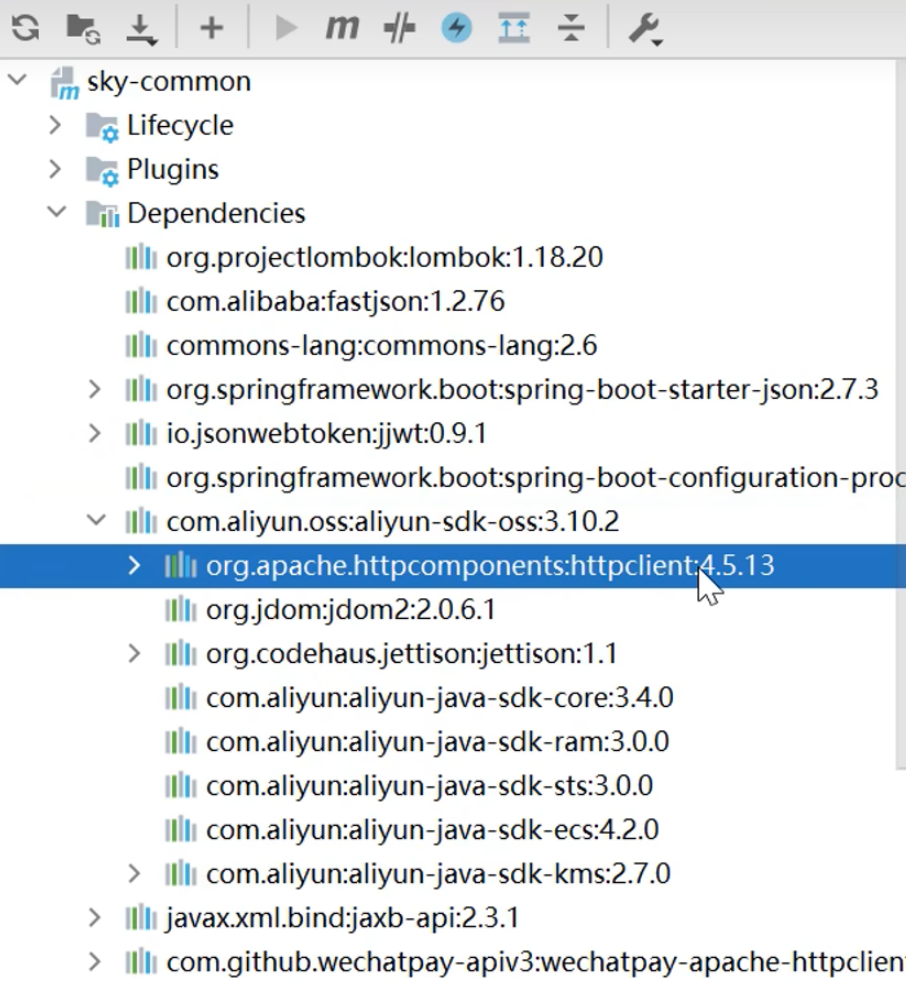
发送get请求
@SpringBootTest //创建测试类
public class HttpClientTest {
/**
* 测试通过httpclient发送get请求
*/
@Test // 创建测试方法
public void testGET() throws IOException {
// 创建httpclient对象
CloseableHttpClient httpClient = HttpClients.createDefault();
// 创建请求对象
HttpGet httpGet = new HttpGet("http://localhost:8080/user/shop/status");
// 发送请求,接收响应结果
CloseableHttpResponse response = httpClient.execute(httpGet);
// 获取影响结果的状态码和数据
int statusCode = response.getStatusLine().getStatusCode();
System.out.println("服务器返回的状态码为:" + statusCode);
HttpEntity entity = response.getEntity();
String body = EntityUtils.toString(entity);
System.out.println("服务端返回的数据为:" + body);
// 关闭资源
response.close();
httpClient.close();
}
}发送post请求
@SpringBootTest //创建测试类
public class HttpClientTest {
/**
* 测试通过httpclient发送post请求
*/
@Test // 创建测试方法
public void testPOST() throws IOException {
// 创建httpclient对象
CloseableHttpClient httpClient = HttpClients.createDefault();
// 创建请求对象
HttpPost httpPost = new HttpPost("http://localhost:8080/admin/employee/login");
// 创建请求参数 (fastjson提供的方法)
JSONObject jsonObject = new JSONObject();
jsonObject.put("username", "admin");
jsonObject.put("password", "123456");
StringEntity entity = new StringEntity(jsonObject.toString());
// 指定请求编码方式
entity.setContentEncoding("utf-8");
// 指定数据格式
entity.setContentType("application/json");
httpPost.setEntity(entity);
// 发起请求
CloseableHttpResponse response = httpClient.execute(httpPost);
// 解析返回的结果
int statusCode = response.getStatusLine().getStatusCode();
System.out.println("响应的状态码为" + statusCode);
HttpEntity entity1 = response.getEntity();
String body = EntityUtils.toString(entity1);
System.out.println("响应的数据为" + body);
// 关闭资源
response.close();
httpClient.close();
}
}使用工具类. 封装HttpClient的操作
/**
* Http工具类
*/
public class HttpClientUtil {
static final int TIMEOUT_MSEC = 5 * 1000;
/**
* 发送GET方式请求
* @param url
* @param paramMap
* @return
*/
public static String doGet(String url,Map<String,String> paramMap){
// 创建Httpclient对象
CloseableHttpClient httpClient = HttpClients.createDefault();
String result = "";
CloseableHttpResponse response = null;
try{
URIBuilder builder = new URIBuilder(url);
if(paramMap != null){
for (String key : paramMap.keySet()) {
builder.addParameter(key,paramMap.get(key));
}
}
URI uri = builder.build();
//创建GET请求
HttpGet httpGet = new HttpGet(uri);
//发送请求
response = httpClient.execute(httpGet);
//判断响应状态
if(response.getStatusLine().getStatusCode() == 200){
result = EntityUtils.toString(response.getEntity(),"UTF-8");
}
}catch (Exception e){
e.printStackTrace();
}finally {
try {
response.close();
httpClient.close();
} catch (IOException e) {
e.printStackTrace();
}
}
return result;
}
/**
* 发送POST方式请求
* @param url
* @param paramMap
* @return
* @throws IOException
*/
public static String doPost(String url, Map<String, String> paramMap) throws IOException {
// 创建Httpclient对象
CloseableHttpClient httpClient = HttpClients.createDefault();
CloseableHttpResponse response = null;
String resultString = "";
try {
// 创建Http Post请求
HttpPost httpPost = new HttpPost(url);
// 创建参数列表
if (paramMap != null) {
List<NameValuePair> paramList = new ArrayList();
for (Map.Entry<String, String> param : paramMap.entrySet()) {
paramList.add(new BasicNameValuePair(param.getKey(), param.getValue()));
}
// 模拟表单
UrlEncodedFormEntity entity = new UrlEncodedFormEntity(paramList);
httpPost.setEntity(entity);
}
httpPost.setConfig(builderRequestConfig());
// 执行http请求
response = httpClient.execute(httpPost);
resultString = EntityUtils.toString(response.getEntity(), "UTF-8");
} catch (Exception e) {
throw e;
} finally {
try {
response.close();
} catch (IOException e) {
e.printStackTrace();
}
}
return resultString;
}
/**
* 发送POST方式请求
* @param url
* @param paramMap
* @return
* @throws IOException
*/
public static String doPost4Json(String url, Map<String, String> paramMap) throws IOException {
// 创建Httpclient对象
CloseableHttpClient httpClient = HttpClients.createDefault();
CloseableHttpResponse response = null;
String resultString = "";
try {
// 创建Http Post请求
HttpPost httpPost = new HttpPost(url);
if (paramMap != null) {
//构造json格式数据
JSONObject jsonObject = new JSONObject();
for (Map.Entry<String, String> param : paramMap.entrySet()) {
jsonObject.put(param.getKey(),param.getValue());
}
StringEntity entity = new StringEntity(jsonObject.toString(),"utf-8");
//设置请求编码
entity.setContentEncoding("utf-8");
//设置数据类型
entity.setContentType("application/json");
httpPost.setEntity(entity);
}
httpPost.setConfig(builderRequestConfig());
// 执行http请求
response = httpClient.execute(httpPost);
resultString = EntityUtils.toString(response.getEntity(), "UTF-8");
} catch (Exception e) {
throw e;
} finally {
try {
response.close();
} catch (IOException e) {
e.printStackTrace();
}
}
return resultString;
}
private static RequestConfig builderRequestConfig() {
return RequestConfig.custom()
.setConnectTimeout(TIMEOUT_MSEC)
.setConnectionRequestTimeout(TIMEOUT_MSEC)
.setSocketTimeout(TIMEOUT_MSEC).build();
}
}
小程序开发
介绍
小程序是一种新的开放能力, 可以在微信内被便捷的获取和传播, 同时具有出色的使用体验

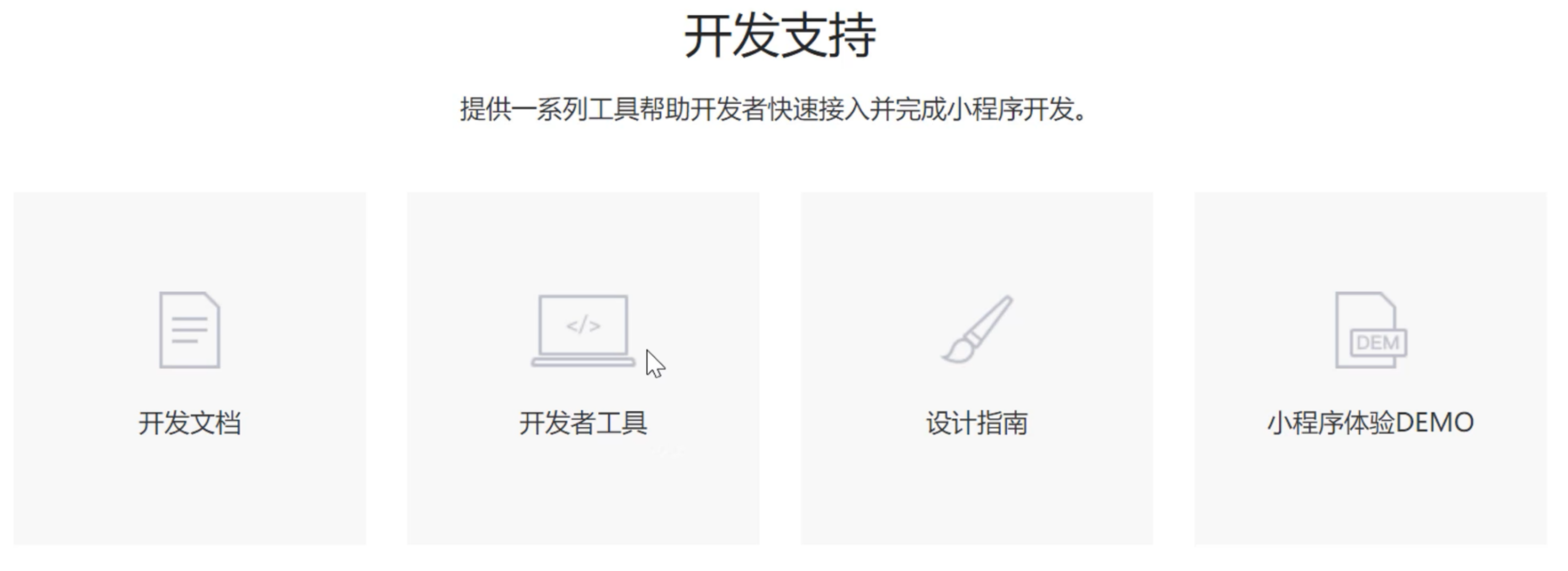
官网: https://mp.weixin.qq.com/cgi-bin/
说明: 个人身份无法开通微信支付功能
接入流程:
- 注册: 在微信公众平台注册小程序, 完成注册后可以同步进行信息完善和开发
- 信息完善: 填写小程序基本信息, 包括名称, 头像, 介绍及服务范围等
- 开发小程序: 完成小程序开发者绑定, 开发信息配置后, 开发者可以下载开发者工具, 参考开发文档进行开发
- 提交审核和发布: 完成小程序开发后, 提交代码至微信团队审核, 审核通过后即可发布
准备
注册小程序: 小程序
完善小程序信息, 获取AppID和小程序秘钥

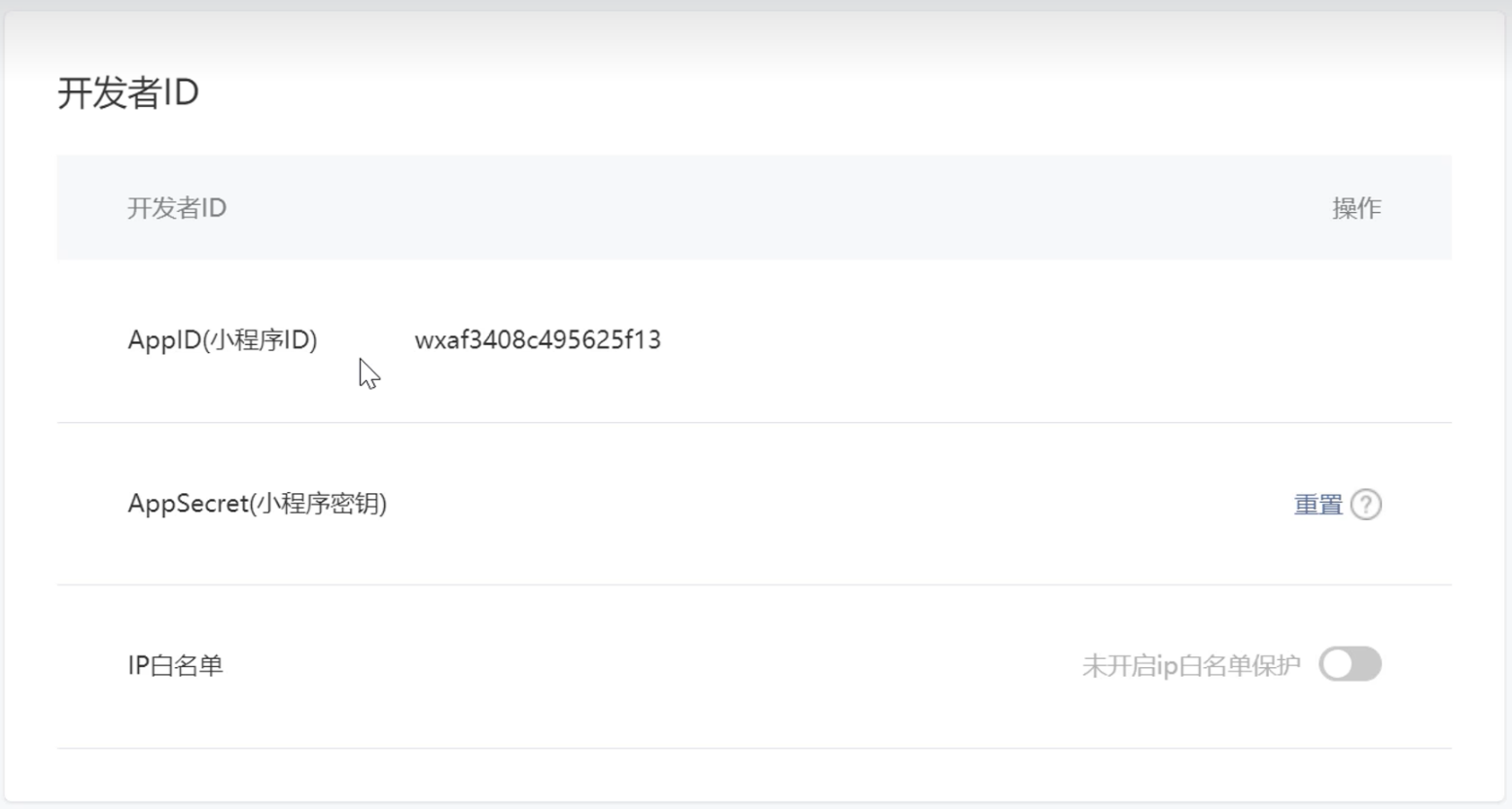
下载开发者工具, 使用开发者工具创建小程序工程

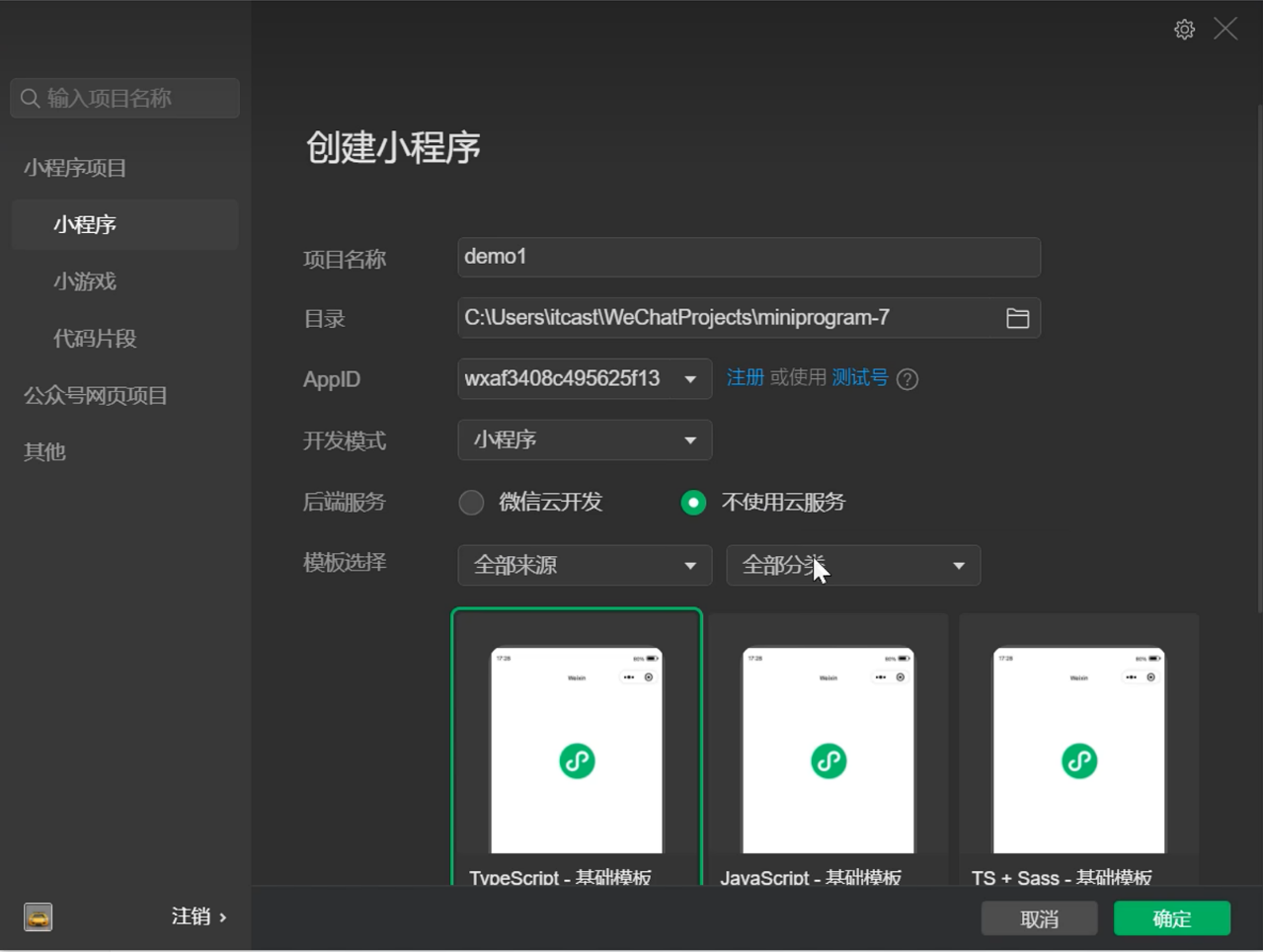

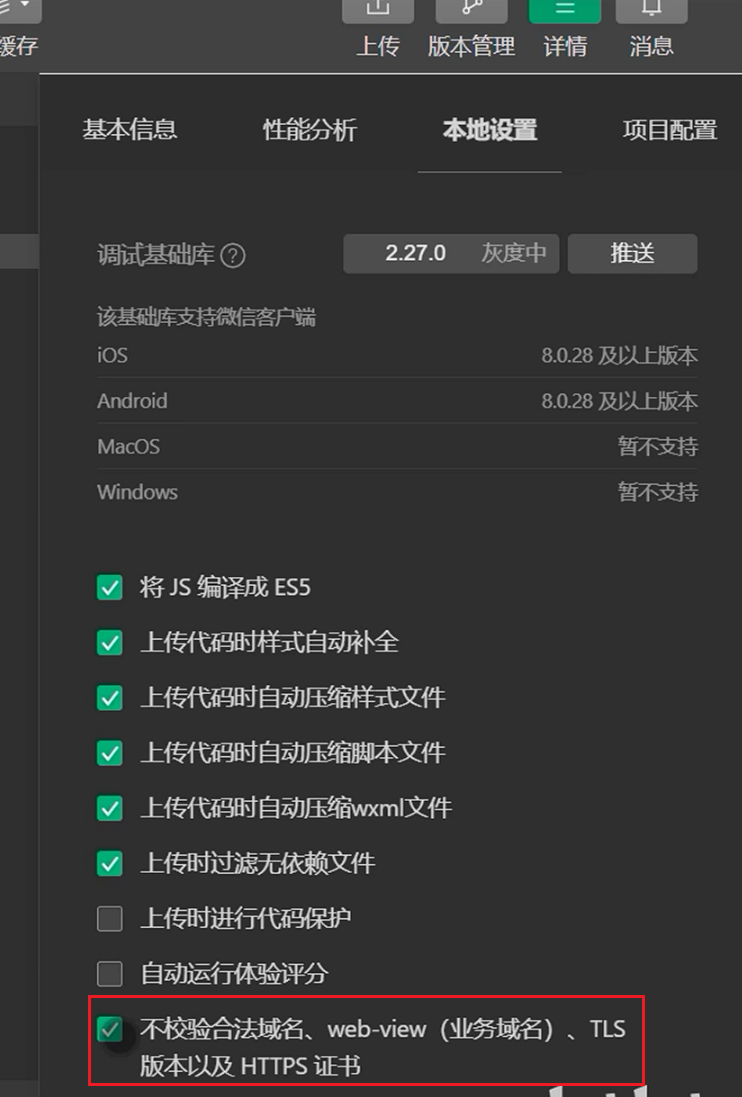
入门
目录结构: 小程序由描述整体程序的app文件和描述页面的page文件组成
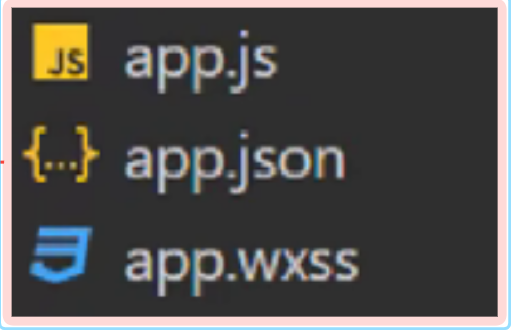
- 小程序的主体部分由三个文件组成,
- 必须放在项目的根目录:
- app.js: 小程序逻辑
- app.json: 小程序公共配置
- app.wxs: 小程序公共样式
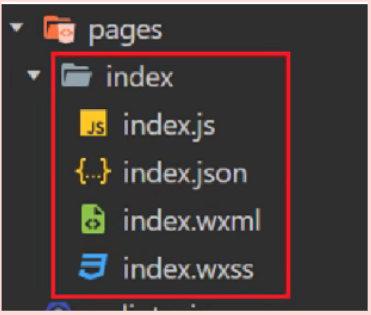
小程序的页面由四个文件组成程
- js: 页面逻辑
- wxml: 页面结构
- json: 页面配置
- wxss: 页面样式表
基础语法: 了解微信小程序的基础语法
page({
// 定义数据
data: {
mag: 'hello word',
code: ''
},
// 获取用户信息
getUserInfo() {
wx.geyUserProfile({
desc: '获取用户信息',
success: (res) => {
console.log(res.userInfo)
}
})
},
// 微信登录: 获取微信用户的授权码
wxLogin() {
wx.login({
success: (res) => {
//赋值
this.setData({
code: res.code
})
}
})
},
// 发请请求
sendRequest() {
url: 'http://localhost:8080/user/shop/status',
method: 'GET',
success: (res)=>{
console.log(res.data)
}
}
})<view>
// 插值表达式:
<view>{{ msg }}</view>
// 图片标签:
<image style="width 100px; height: 100px;" sec="{{ url }}"></image>
// 绑定事件:
<button bindtap="getUserInfo" type="primary">获取用户信息</button>
</view>发布小程序: 点击上传按钮, 输入版本号, 提交代码到微信开发者管理后台, 在微信后台提交测试版本
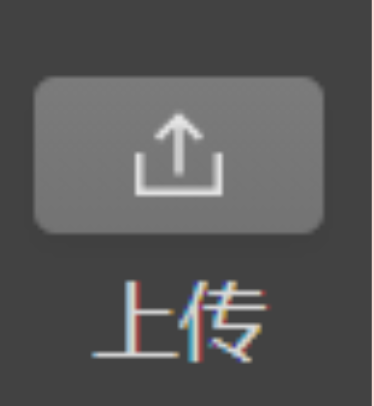
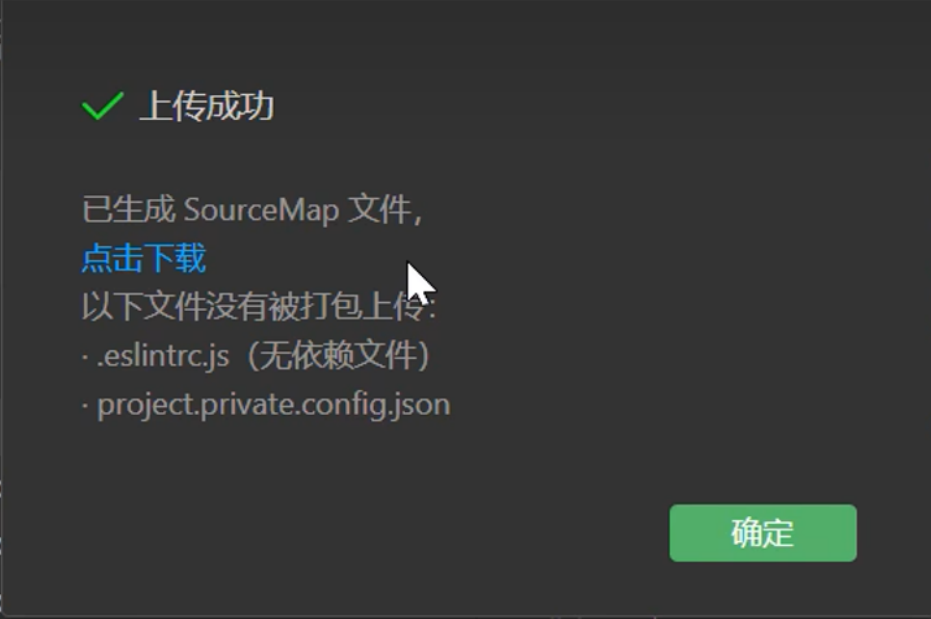

上线小程序: 我们发布的小程序是开发版本 用于测试, 测试完成后, 需要提交审核, 审核通过后才能发布上线



微信登录
准备工作
导入前端代码: 使用微信开发者工具打开 mp-weixin 工程

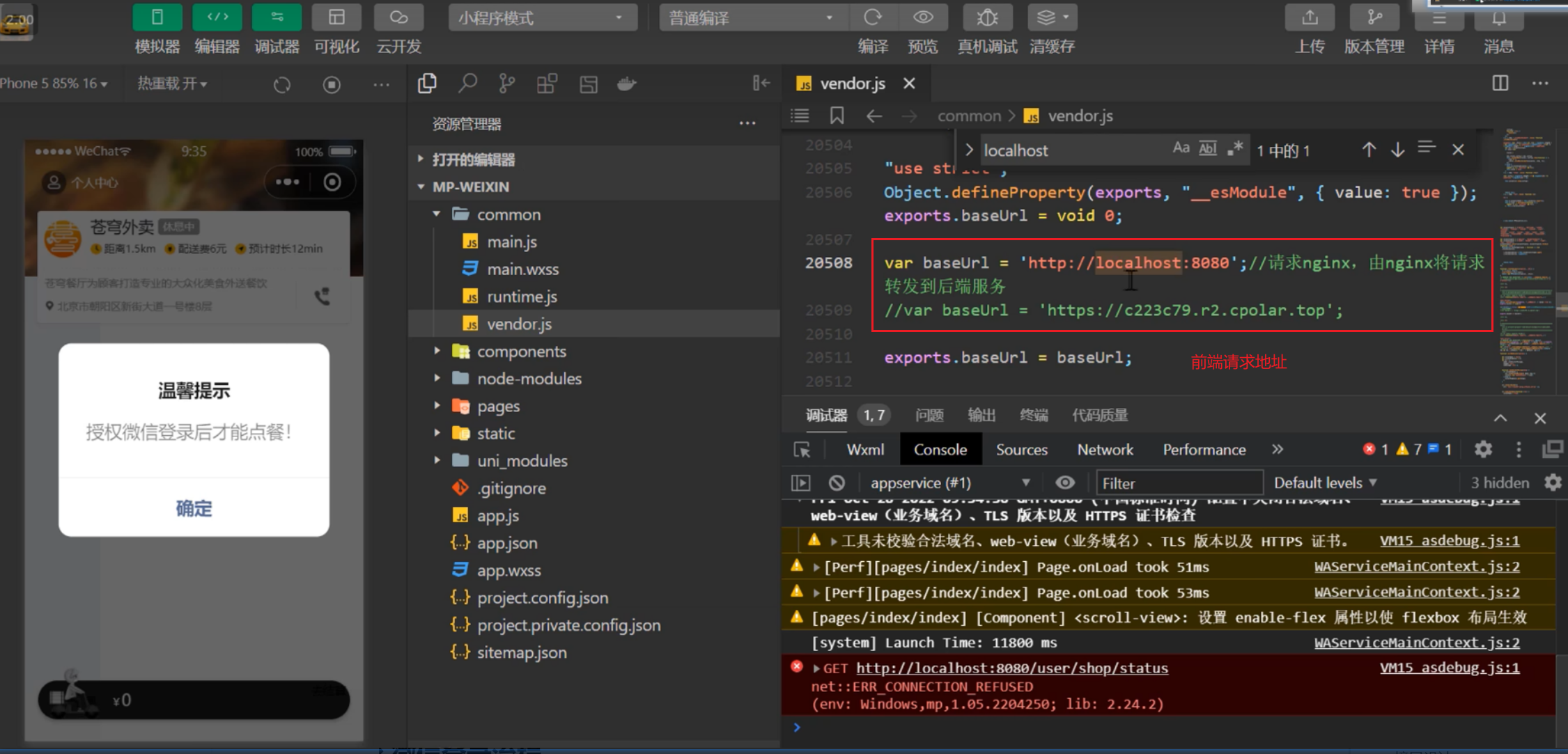
- 注意检查common/vendor.js文件中的baseUrl是否与后端服务一致
了解微信登录流程
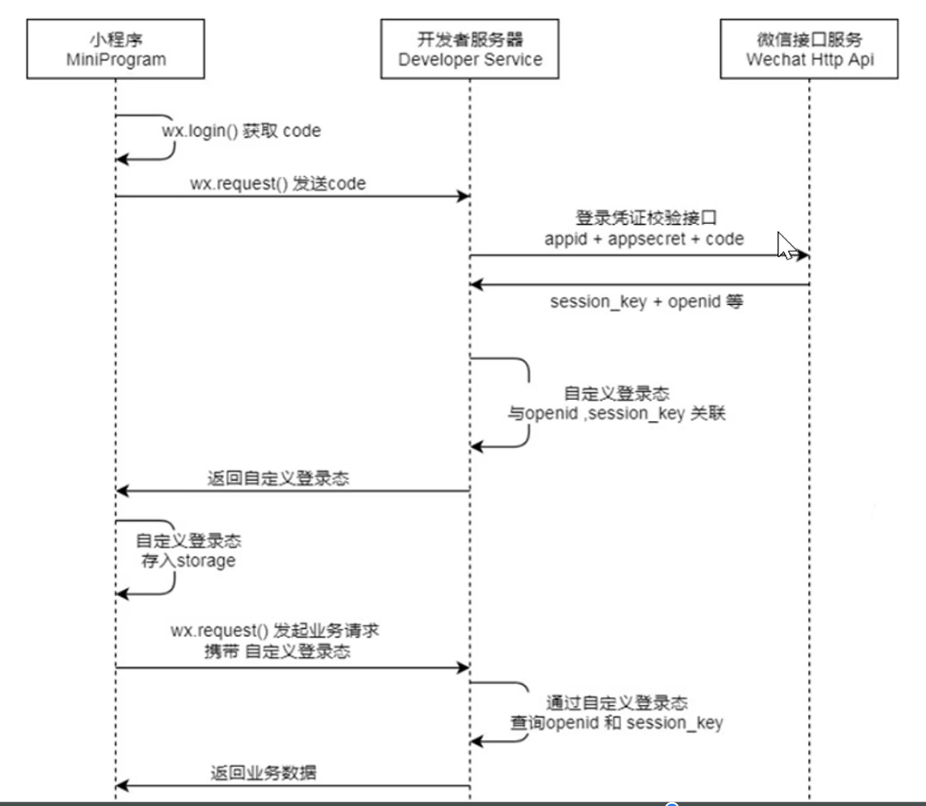
登录流程:
- wx.login()获取code
- wx.request()把code传给后端服务器
- 后端服务器把appid, 小程序秘钥, code授权码传给微信服务器
- 微信服务器返回用户信息,其中最重要的是opedid
- 后端服务器把用户信息储存起来,并生成token令牌,响应给前端
- 前端根据登录状态进行业务操作
- 官网小程序登录 | 微信开放文档
- 测试: 可以使用微信开发者工具获取登录授权码, 使用测试工具校验微信接口
分析和设计
查看原型, 确定需求: 基于微信登录实现小程序的登录功能, 如果是新用户需要自动完成注册
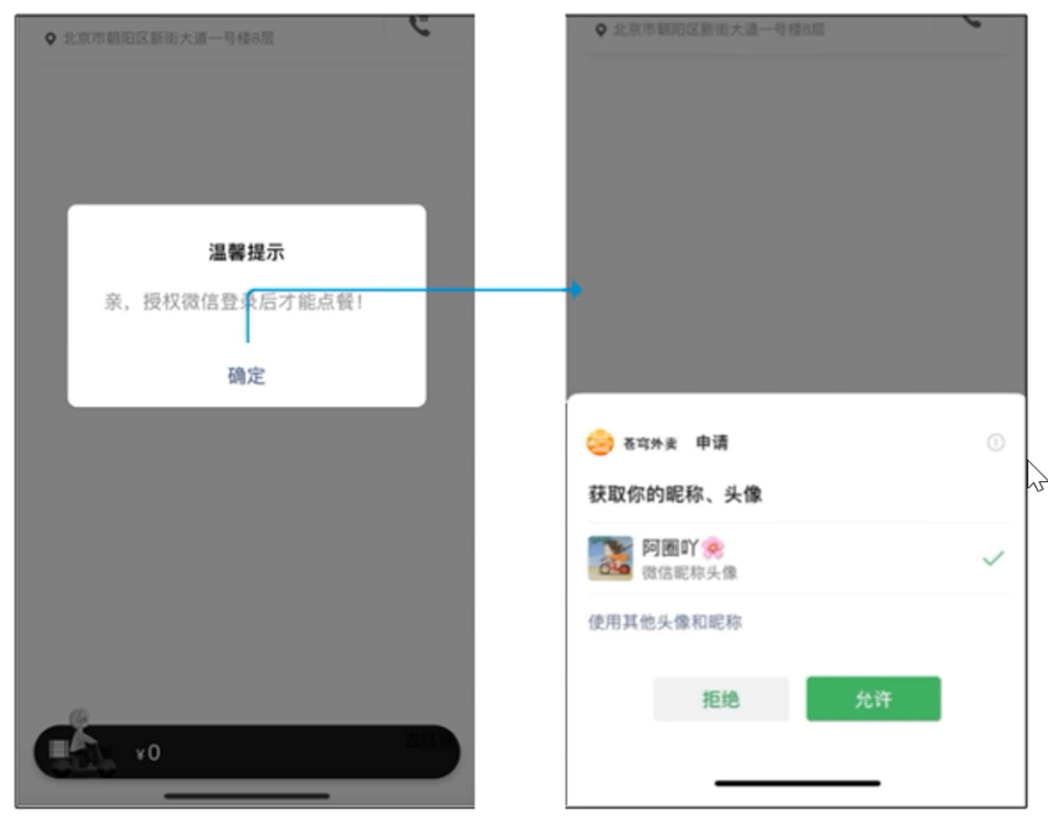
接口设计
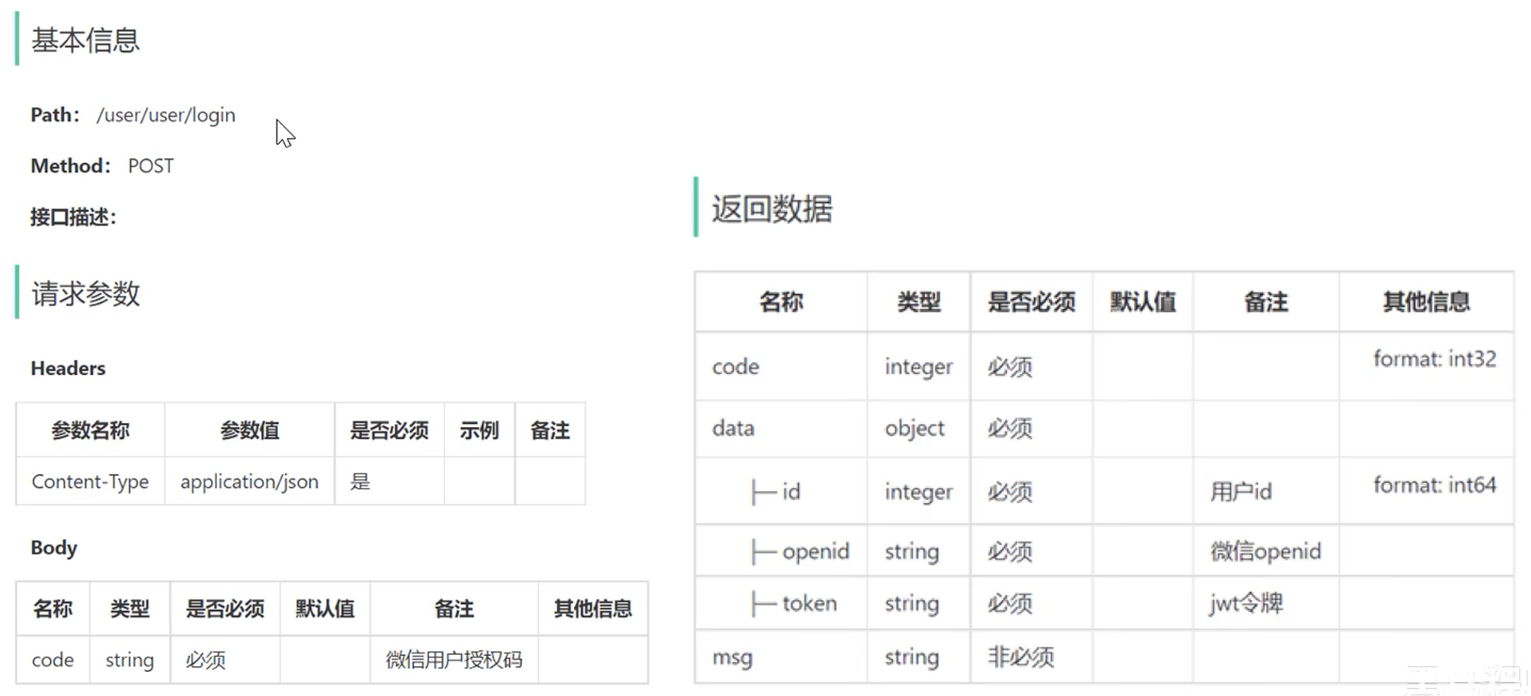
数据表设计: user表, 用户存储用户信息
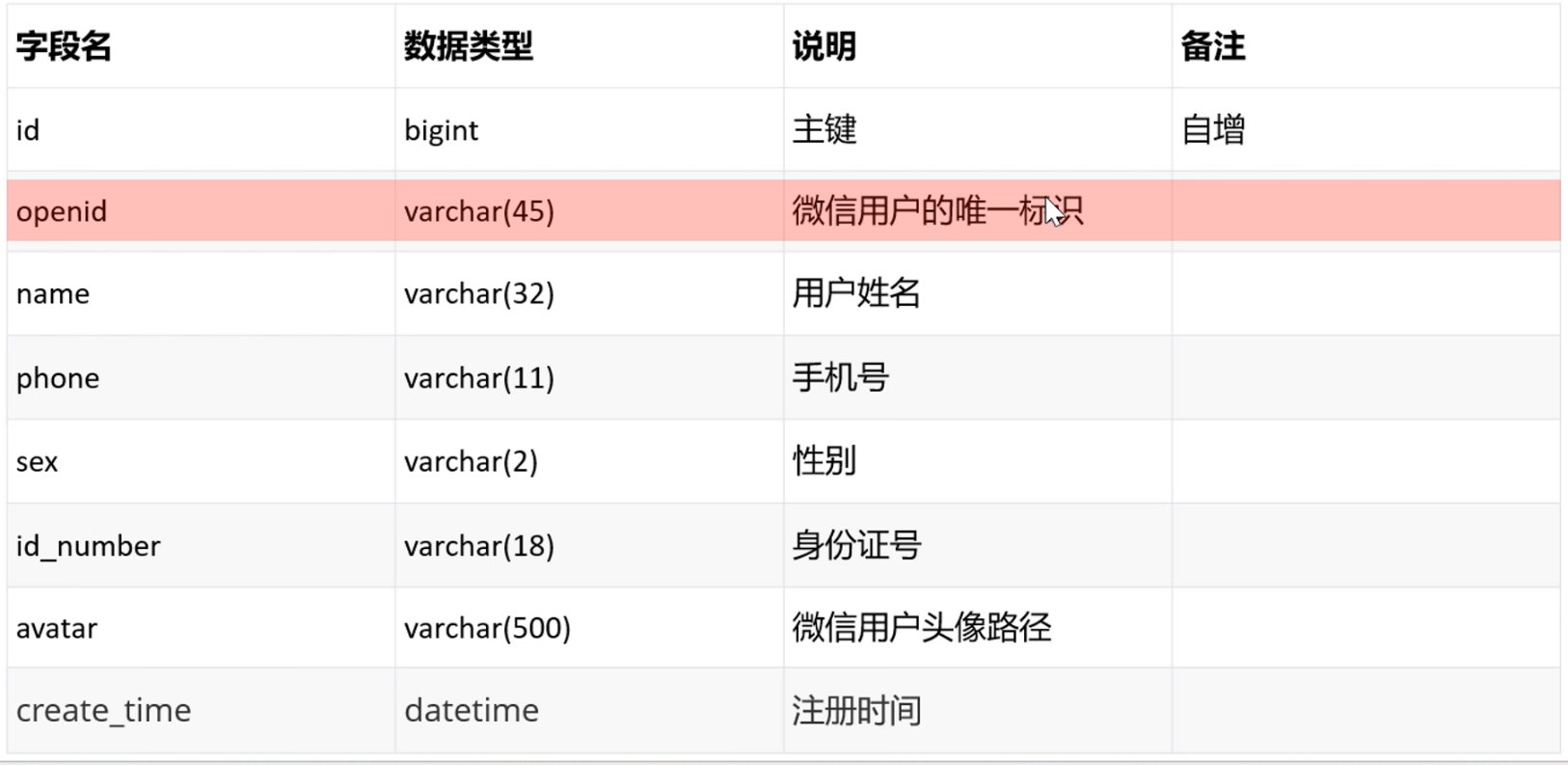
- 个人身份的开发者无法获取微信用户的手机号
代码开发
配置微信登录所需的配置项
sky:
jwt:
# 设置jwt签名加密时使用的秘钥(客户端)
user-secret-key: itheima
# 设置jwt过期时间(客户端)
user-ttl: 7200000
# 设置前端传递过来的令牌名称(客户端)
user-token-name: authentication
wechat:
appid: ${sky.wechat.appid}
secret: ${sky.wechat.secret}sky:
wechat:
appid: wxb161c259ad057fe9
secret: 6695e2fc4c13a6cdd4dc87c3c3baa988配置属性类: 把配置文件中的配置信息封装在配置类的属性中, 供程序调用
// 配置属性封装类, 用于封装配置文件中的数据
// 通过注入该类, 就可以方便的在程序中使用配置类中的数据
@Component
@ConfigurationProperties(prefix = "sky.jwt")
@Data
public class JwtProperties {
/**
* 管理端员工生成jwt令牌相关配置
*/
private String adminSecretKey;
private long adminTtl;
private String adminTokenName;
/**
* 用户端微信用户生成jwt令牌相关配置
*/
private String userSecretKey;
private long userTtl;
private String userTokenName;
}
@Component
@ConfigurationProperties(prefix = "sky.wechat")
@Data
public class WeChatProperties {
private String appid; //小程序的appid
private String secret; //小程序的秘钥
}
准备DTO: 把前端请求参数封装在DTO对象中
/**
* C端用户登录
*/
@Data
public class UserLoginDTO implements Serializable {
private String code;
}准备VO: 把后端返回给前端的数据封装在VO对象中
@Data
@Builder
@NoArgsConstructor
@AllArgsConstructor
public class UserLoginVO implements Serializable {
private Long id;
private String openid;
private String token;
}Controller: 新建UserController
@RestController
@RequestMapping("/user/user")
@Api(tags = "用户相关接口")
@Slf4j
public class UserController {
@Autowired
private UserService userService;
@Autowired
private JwtProperties jwtProperties;
@PostMapping("/login")
@ApiOperation("微信登录")
public Result<UserLoginVO> login(@RequestBody UserLoginDTO userLoginDTO) {
log.info("微信用户登录: {}", userLoginDTO);
// 微信登录
User user = userService.wxLogin(userLoginDTO);
// 为微信用户生成JWT令牌
Map<String, Object> claims = new HashMap<>();
claims.put(JwtClaimsConstant.USER_ID, user.getId());
String token = JwtUtil.createJWT(jwtProperties.getUserSecretKey(), jwtProperties.getUserTtl(), claims);
// 封装响应数据
UserLoginVO userLoginVO = UserLoginVO.builder().id(user.getId()).openid(user.getOpenid()).token(token).build();
return Result.success(userLoginVO);
}
}Service: 新建UserService接口和UserServiceImpl实现类
public interface UserService {
/**
* 微信登录
* @param userLoginDTO
* @return
*/
User wxLogin(UserLoginDTO userLoginDTO);
}@Service
@Slf4j
public class UserServiceImpl implements UserService {
// 微信服务接口地址
public static final String WX_LOGIN = "https://api.weixin.qq.com/sns/jscode2session";
@Autowired
private WeChatProperties weChatProperties;
@Autowired
private UserMapper userMapper;
/**
* 微信登录
*
* @param userLoginDTO
* @return
*/
public User wxLogin(UserLoginDTO userLoginDTO) {
// 获取openid
String openid = getOpenid(userLoginDTO.getCode());
// 判断openid是否为空, 如果空表示登录失败, 抛出异常
if (openid == null) {
throw new LoginFailedException(MessageConstant.LOGIN_FAILED);
}
// 判断当前用户是否为新用户
User user = userMapper.getByOpenid(openid);
// 新用户要实现自动注册
if (user == null) {
user = User.builder()
.openid(openid)
.createTime(LocalDateTime.now())
.build();
userMapper.insert(user);
}
// 返回这个用户对象
return user;
}
/**
* 调用微信接口服务, 获取微信用户的openid
* @param code
* @return
*/
private String getOpenid(String code) {
// 调用微信接口服务, 获得放前微信用户的openid
HashMap<String, String> map = new HashMap<>();
map.put("appid", weChatProperties.getAppid());
map.put("secret", weChatProperties.getSecret());
map.put("js_code", code);
map.put("grant_type", "authorization_code");
String json = HttpClientUtil.doGet(WX_LOGIN, map);
JSONObject jsonObject = JSON.parseObject(json);
String openid = jsonObject.getString("openid");
return openid;
}
}Mapper: 新建UserMapper
@Mapper
public interface UserMapper {
/**
* 根据openid查询用户
* @param openid
* @return
*/
@Select("select * from user where openid = #{openid}")
User getByOpenid(String openid);
/**
* 新增用户
* @param user
*/
void insert(User user);
}<?xml version="1.0" encoding="UTF-8" ?>
<!DOCTYPE mapper PUBLIC "-//mybatis.org//DTD Mapper 3.0//EN"
"http://mybatis.org/dtd/mybatis-3-mapper.dtd" >
<mapper namespace="com.sky.mapper.UserMapper">
<insert id="insert" useGeneratedKeys="true" keyProperty="id">
insert into user (openid, name, phone, sex, id_number, avatar, create_time)
values (#{openid}, #{name}, #{phone}, #{sex}, #{idNumber}, #{avatar}, #{createTime})
</insert>
</mapper>
JWT校验
定义拦截器
/**
* jwt令牌校验的拦截器
*/
@Component
@Slf4j
public class JwtTokenUserInterceptor implements HandlerInterceptor {
@Autowired
private JwtProperties jwtProperties;
/**
* 校验jwt
*
* @param request
* @param response
* @param handler
* @return
* @throws Exception
*/
public boolean preHandle(HttpServletRequest request, HttpServletResponse response, Object handler) throws Exception {
//判断当前拦截到的是Controller的方法还是其他资源
if (!(handler instanceof HandlerMethod)) {
//当前拦截到的不是动态方法,直接放行
return true;
}
//1、从请求头中获取令牌
String token = request.getHeader(jwtProperties.getUserTokenName());
//2、校验令牌
try {
log.info("jwt校验:{}", token);
Claims claims = JwtUtil.parseJWT(jwtProperties.getUserSecretKey(), token);
Long userId = Long.valueOf(claims.get(JwtClaimsConstant.USER_ID).toString());
log.info("当前员工id:", userId);
BaseContext.setCurrentId(userId);
//3、通过,放行
return true;
} catch (Exception ex) {
//4、不通过,响应401状态码
response.setStatus(401);
return false;
}
}
}注册拦截器
/**
* 配置类,注册web层相关组件
*/
@Configuration
@Slf4j
public class WebMvcConfiguration extends WebMvcConfigurationSupport {
private JwtTokenUserInterceptor jwtTokenUserInterceptor;
/**
* 注册自定义拦截器
*
* @param registry
*/
protected void addInterceptors(InterceptorRegistry registry) {
log.info("开始注册自定义拦截器...");
registry.addInterceptor(jwtTokenUserInterceptor)
.addPathPatterns("/user/**")
.excludePathPatterns("/user/user/login")
.excludePathPatterns("/user/shop/status");
}
}商品浏览
需求分析
查看产品原型
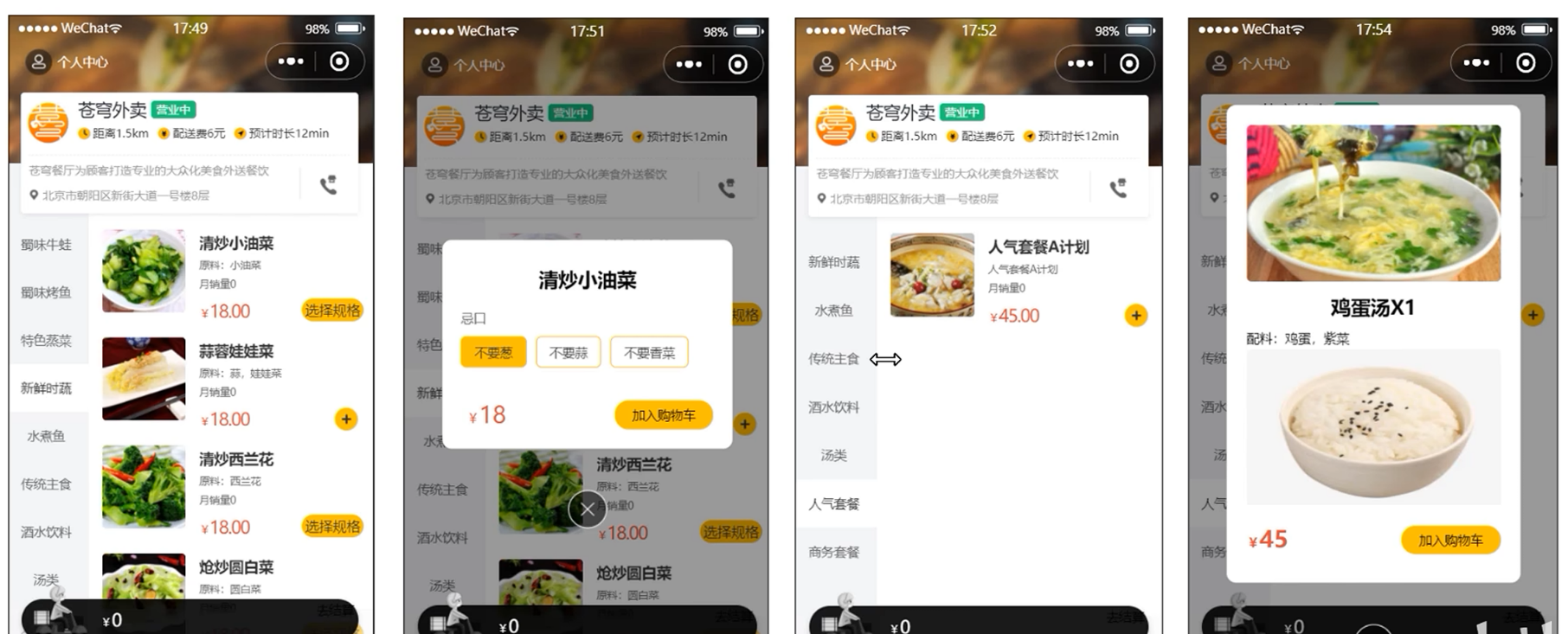
接口设计
查询分类接口


根据分类id查询菜品
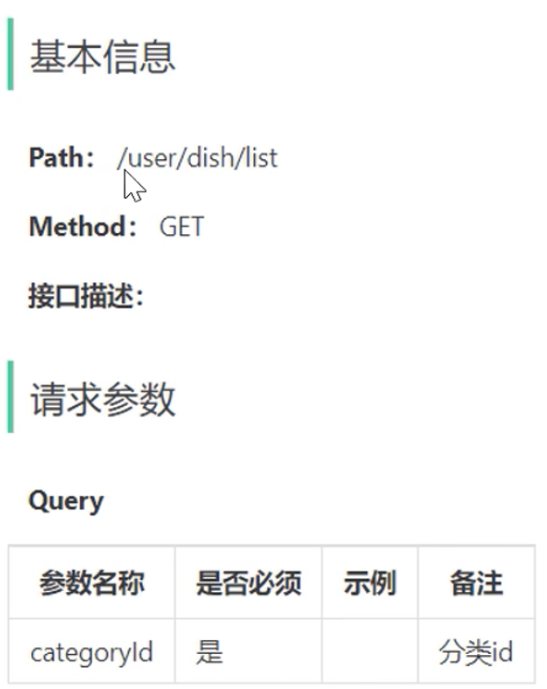
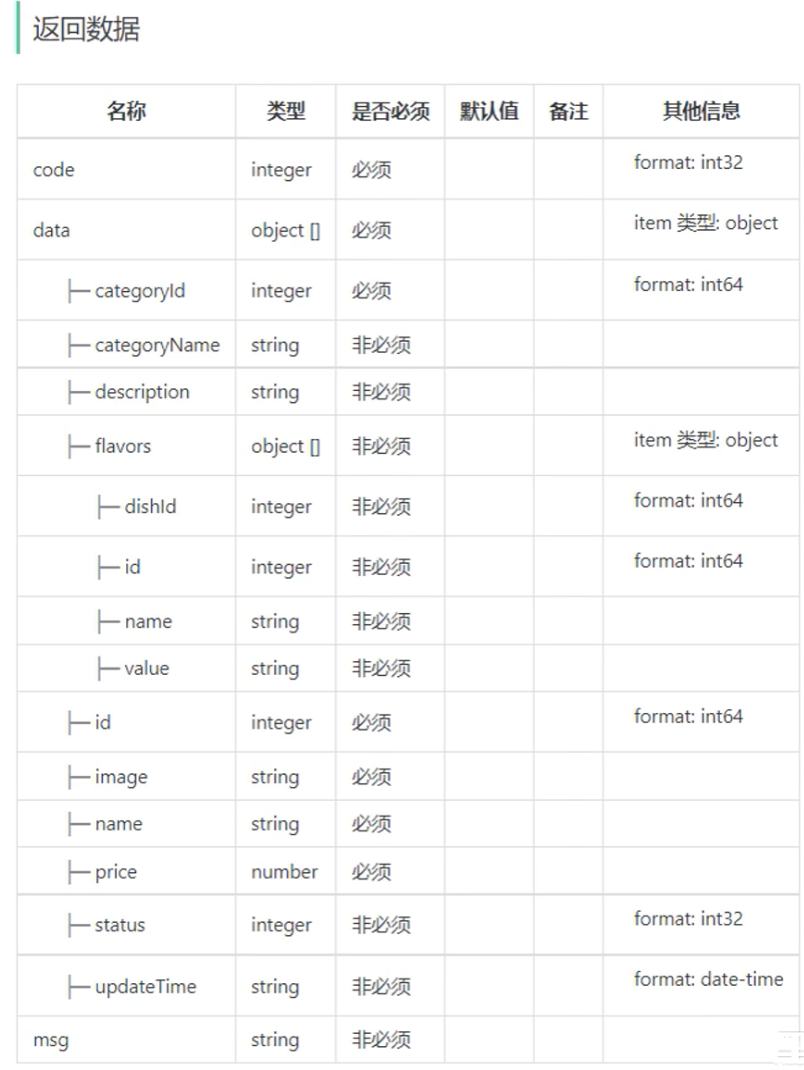
根据分类id查询套餐

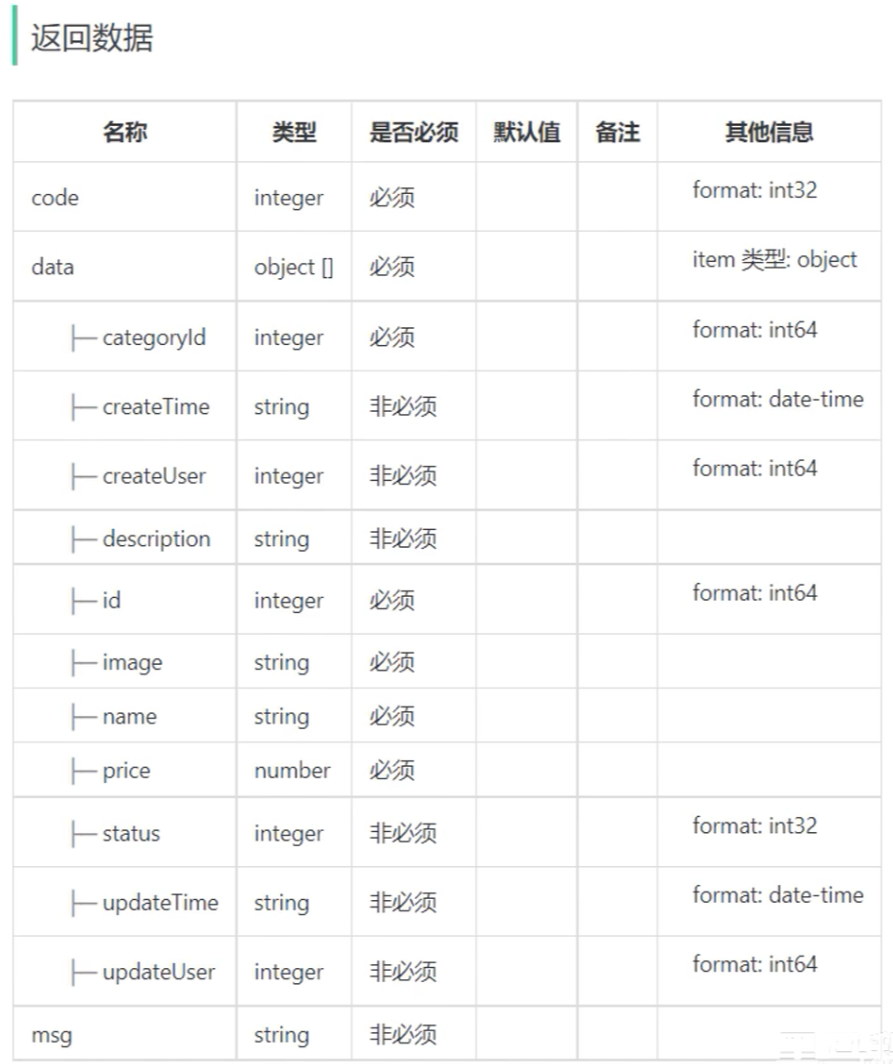
根据套餐id查询包含的菜品

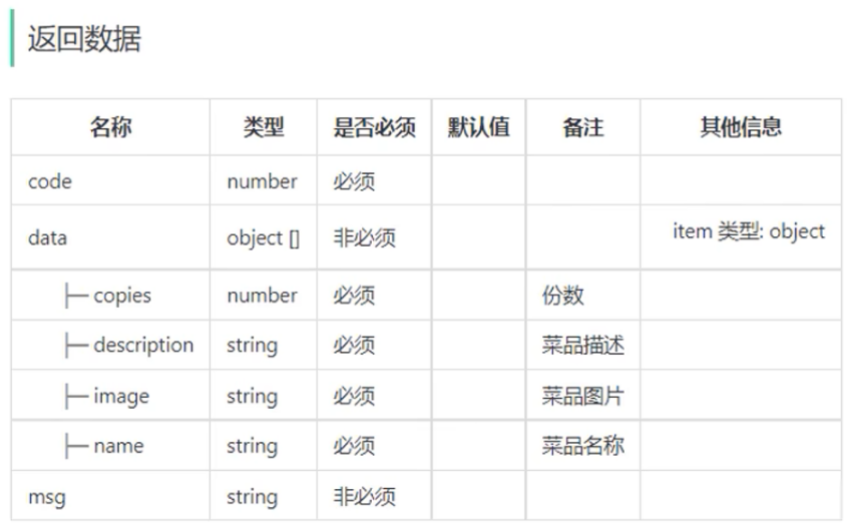
功能实现
代码导入: day06-微信登录-商品浏览/资料/代码导入

前后端联调功能测试
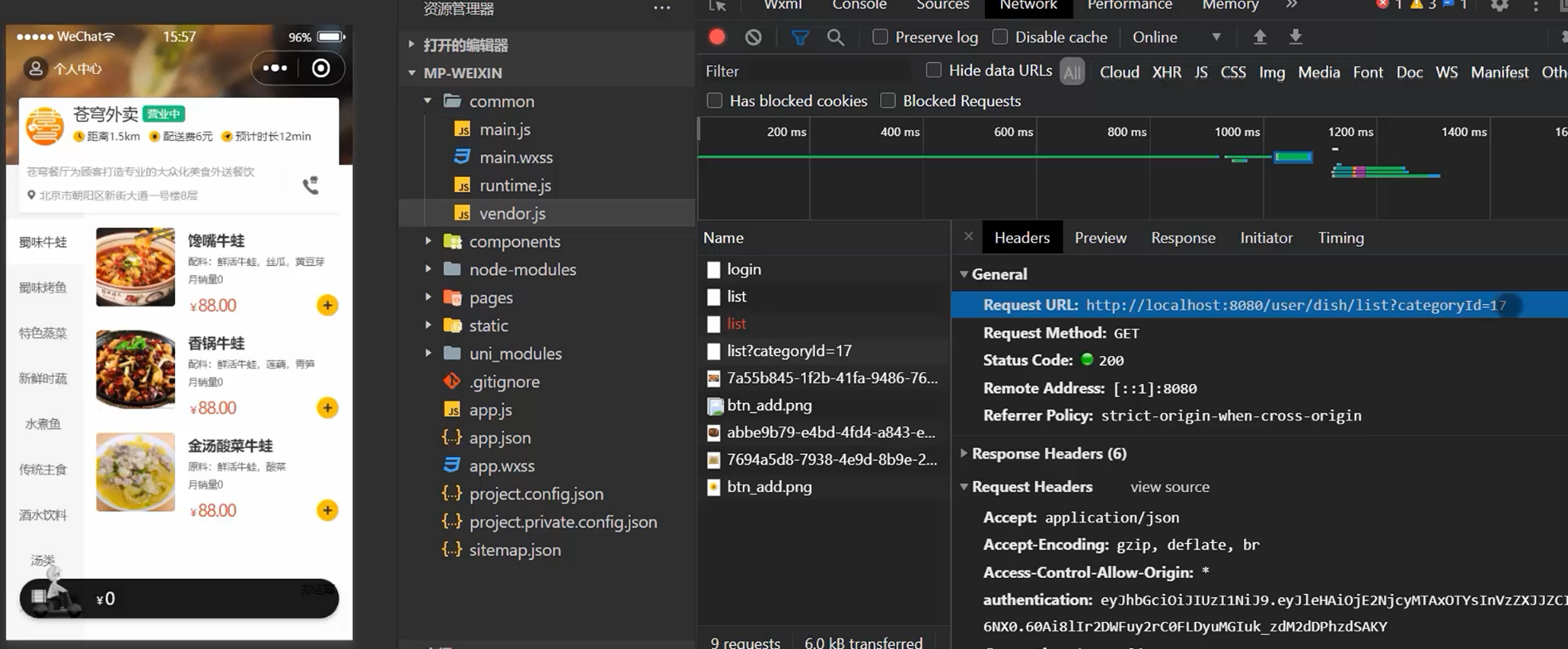






















 2万+
2万+

 被折叠的 条评论
为什么被折叠?
被折叠的 条评论
为什么被折叠?








